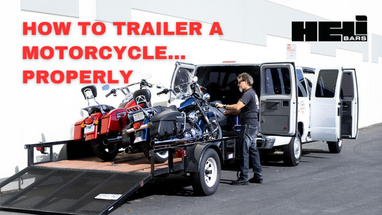Sep 29th 2023
How to Trailer A Motorcycle… Properly!
While we’re all in favor of long-distance rides where you can enjoy your motorcycle while you travel to your destination, sometimes it just isn’t practical. You might be packing up the whole family to spend time at a vacation home, crossing state lines to head to a rally, or heading to a competition. There are just some situations where trailering your bike just makes more sense than riding it.
But there is a right and a wrong way to go about loading up a motorcycle (or multiple) and last thing you want is to cause damage to your bike in the process. Whether you’ve trailered a motorcycle many a time or this is your first, the tips below will help you ensure a safe journey for you and your bike.
Choosing a Motorcycle Trailer
Motorcycle trailers have come a long way and there are many different options on the market to match your budget, frequency of use, size requirements and more. While we won’t get into specific brands, there are three main types of motorcycle trailers:
- Open flatbed trailers: This standard trailer type is a wheeled flat platform that can be hitched to your car. They come in small and large sizes to accommodate multiple bikes and sometimes have low sidewalls. They’re an affordable option but their open-air style offers little extra protection for your bike.
- Enclosed trailer: Generally larger and definitely more expensive, enclosed trailers offer full coverage for your bike, protecting it from any debris or weather you might encounter in your travels.
- Hitch carriers: The most budget-friendly and minimalist option allows you to hook or mount your bike directly to your car. While they do save space and money, they are limited to smaller bikes and are designed for shorter distance travel.

It often comes down to personal preference and the load capacity of individual trailers but for simplicity’s sake, the rest of this blog will guide you through trailering your motorcycle on a standard open flatbed.
Getting Familiar With Driving A Trailer
Trailers often more than double the length of your vehicle which changes the driving experience and safety considerations. No matter your confidence level, it’s always smart to practice driving with a trailer before you load your bike up and hit the road. Pick a quiet time to take a few laps around your neighborhood to get a feel for the change in weight distribution and pedal patterns. Seek out an empty parking lot where you can practice driving in reverse, turning slowly to avoid jackknifing the trailer.
Remember that driving with a trailer will require you to take wider turn, keep a greater distance between you and the next car, and be more gradual with your stops and starts. This is also a good time to check your mirrors repeatedly while practicing to see if there loose objects or overly dramatic movement of the trailer that should be corrected before you hit the road.
Acquire the Right Tie Downs & Other Tools
There are two basic types of tie down straps including cam buckles and ratchet straps. Cam buckles uses friction created as the strap passes through spring-loaded buckle to keep the tie down in place. They are quick, easy to use, affordable and generally strong enough for most motorcycle tie-down scenarios. Rachet straps use a small, ratcheting gear to progressively tighten the strap, allowing you to fasten the bike more securely. However, it’s possible to make too much tension with a ratchet strap, potentially damaging your bike so care must be taken when using these. With either option, be sure to check the weight capacity before purchasing.
A wheel chock is also helpful, keeping your front wheel in place as you tie everything down. Made of either plastic or metal, this extra tool can making trailering your bike a lot easier, especially if you’re working solo.
Loading Your Motorcycle
This next step is perhaps the most nerve-wracking part of trailering a motorcycle. There are plenty of horror stories of bikers who have ruined their motorcycles by driving the bike into their vehicle or off the trailer entirely when loading it up so it’s essential that you take care during this step. Most trailers come with a fold down ramp to make things simpler. If your bike is light enough or you have some helping hands, the safest option is to push it up the ramp. But going uphill with a 500 lb bike isn’t always possible. You can also ride your bike up the ramp slowly, in a low gear—you may want to practice some slow uphill riding first…
Once your bike is on the trailer, keep it in gear when you shut it off. This makes it less likely to roll around if it happens to get dislodged from the tie downs.
Securing Your 4 Tie Down Points
Now you’re ready to use your choice of tie down straps to secure the bike to your trailer. We wouldn’t be surprised if as many motorcycles were damaged by bad tie down jobs than by crashes on the road. For maximum security, you should always have four tie down points with two in the front and two in the back to create an X pattern.
To start, use your bike’s kickstand to hold it upright. Once you have one side tightened, you’ll be able to pull the bike vertical and tuck the kickstand in.
One of the biggest mistakes when trailering a bike is that motorcyclists use their handlebars as a tie down point. Stock handlebars and handlebar risers alike should not be used as a primary tie down point. Too much tension on the handlebars can warp and damage them, even voiding your warranty in some cases—or worse, the pressure can cause them to rotate in the clamp, releasing the tension that’s holding your bike in place while your hurtle down the highway.
Pass the strap through the frame or fork stanchions above the triple tree, ensuring only the strap touches your bike, not the metal hooks. Attach the hooks to the tie down points on your trailer on either side of the bike. Tighten enough to get rid of any slack. In the back, run a strap around your bike’s frame, subframe or rear swingarm and attach the hooks to either side of your trailer.
Straighten your bike and begin tightening your straps until everything is evenly tensioned, being careful not to overdo it. For reference, you want to compress no more than half the travel in your front suspension. Optionally, you can add secondary soft straps to your handlebars and rear wheel to minimize lateral movement but avoid tensioning these greatly. Give your bike a good shake to test its security and consider taking another test drive around the neighborhood.
More Protection for Trailering a Motorcycle
This setup should be pretty bombproof but there are some additional measures you can take to protect your bike while travelling long distances. For example, you might add a cover or tarp on top of your bike to mitigate rain, dirt, rocks and other harmful debris kicked up on the road. Tie your covering of choice directly to the bike rather than the trailer and because it isn’t load bearing you don’t need to worry about ratcheting the straps tightly.
Depending on the stops you plan to make along your journey or your final destination, you may also want to consider getting a lock to ensure your bike (or entire trailer) isn’t stolen during your travels. While it may be impossible to stop a determined thief, you can use coupler lock to prevent access to the trailer-hitch latch or any high security lock and chain that can fit through your wheel spokes.
Heading out with your bike? Shoot us a message to share what motorcycle adventure you’re on. Tell us your best story—epic fail or total success—of trailering a bike or share any additional tips for safely transporting your motorcycle. We love to hear your experiences and incorporate them into our blogs and even use them to inform our product design.

